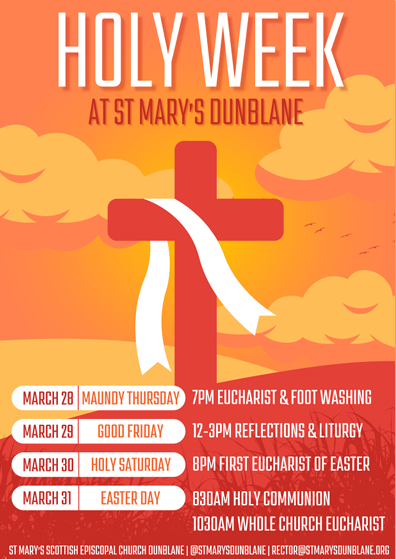Nerys writes: Today is a day when we as Christians as called to do two things, to remember and to pray. It is 91 years since Armistice or Remembrance Day was first held to recall the end of the First World War when around 37 million people, both military and civilian, were killed or injured. Today, armed conflict is happening within at least 14 countries in the world – in Mayanmar, Afghanistan, Iraq and Syria, Colombia and Mexico, Ethiopia, Mali, Nigeria, Somalia, South Sudan, Burkina Faso, Democratic Republic of Congo, Sudan and Yemen. In these countries, thousands of people have been killed this year. In Mayanmar alone there have been 13, 500 casualties during the last ten months. And in February, the Russian Federation began a military invasion of Ukraine which has resulted in the deaths of at least 30,000 soldiers on both sides, the deaths of over 6,000 Ukrainian civilians and the displacement of more than 5.5 million. As we remember today the seven young men from St Mary’s who lost their lives in the Second World War – Ronald Gutteridge, William Guthrie, Alastair Guthrie, Frank Wilson, Fredrick Lax, John Fowler, Allan Heywood Ball – we also remember all victims of war and pray for peace.
Today’s readings are Job 19.21-27, 1 Corinthians 15.51-57 and John 6.37-40.
Our Scriptures teach us that down the ages, remembering and praying has shaped the future of the people of God. The story of Job was designed to remind the Jewish people of the need to trust in God’s promises even in the midst of suffering and in the face of death. God’s chosen people often forgot these promises but they are the foundation of any relationship with God. Jesus made the same promises, that if anyone comes to him, he will hold on to them and never let them go, that anyone who trusts who he is and aligns with him will enter real life, eternal life. This is the mystery of our faith, the mystery St Paul talks about in his first letter to the Corinthians. As we listen to these three readings, let us also remember the amazing transformative power of God’s spirit who is alive within us and between us. We remember all these things so that they will shape our lives and enable us to make a difference to our broken world.
This year once more, poppies have been made available in our church porch – red poppies which represent a commitment to remember those who have served and died in past wars and white poppies which represent a commitment to work and pray for peace. I wonder if you’ve ever thought how the poppy came to be the symbol used for Remembrance and what the red and white poppies represent?
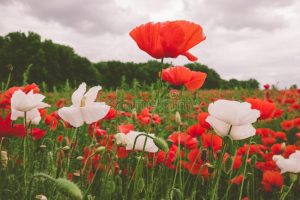
As you know, from 1914 to 1918, what became known as the First World War, took a greater human toll than any previous conflict, with some 8.5 million soldiers dead of battlefield injuries or disease. The Great War, as it was then known, also ravaged the landscape of those areas where most of the fiercest fighting took place. In the battlefields in Flanders and Picardy, churned up by fighting and shelling, one of the only plants that grew among the trenches and the mud was the red corn poppy.
It was this flower which provided a young Canadian soldier and surgeon, Lieutenant Colonel John McCrae with inspiration for a poem which he wrote whilst serving on the front line in 1915. As he tended to the wounded, McCrae saw first-hand the carnage which resulted from the Second Battle of Ypres where some 87,000 Allied soldiers were killed or wounded, as well as 37,000 on the German side. A friend of McCrae’s, Lieutenant Alexis Helmer, was among the dead.
Struck by the sight of the bright red flowers growing on the broken ground, McCrae wrote a poem giving a voice to the fallen soldiers buried under those hardy poppies.
In Flanders fields the poppies blow
between the crosses, row on row,
that mark our place; and in the sky
the larks, still bravely singing, fly
scarce heard amid the guns below.
We are the dead. Short days ago
we lived, felt dawn, saw sunset glow,
loved, and were loved, and now we lie
in Flanders fields.
Take up our quarrel with the foe:
to you from failing hands we throw
the torch; be yours to hold it high.
If ye break faith with us who die
we shall not sleep, though poppies grow
in Flanders fields.
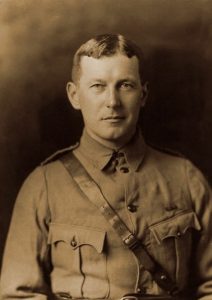
The poet John McCrae
The poem was published in Punch magazine and was used at countless memorial services in the months that followed so that by 1917 ‘In Flanders Fields’ was known throughout Europe and the English-speaking world. Immediately after the war, inspired by the poem, the French government used the red poppy as the emblem of an organisation to raise funds for those living in the devastated regions of France. Anna Guerln who had spent the war travelling around the USA, lecturing and raising funds for French widows, orphans and veterans, was sent back to set up an American branch of the organisation. She soon began organising Poppy Days when paper poppies would be distributed in exchange for donations. These took off and soon silk poppies made by French women, children and veterans were being imported to the US as a way of funding the rebuilding war-torn France.
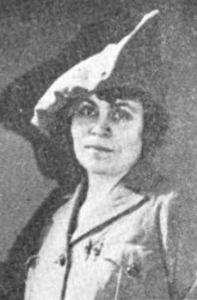

Anna Guerin and Monia Michael
In 1920, Mme Guerin started to promote the idea that all World War I allies should use artificial poppies to remember their fallen soldiers. The idea was taken up by Monia Michael, an American academic and well-known humanitarian. The American Legion gave her their support, the red poppy was adopted as the official US national emblem of Remembrance and a national distribution programme began in 1924.
In the meantime, Mme Guerin had brought her campaign to the United Kingdom, where she persuaded Earl Haig one of the founders of the British Legion to adopt the poppy as their symbol. In November 1921 the Legion held its first ever Poppy Appeal which almost immediately ran out of poppies and raised over £100,000 to provide housing and employment for veterans and their families. The following year, a factory, staffed by disabled ex-servicemen was set up in Richmond, so that the Legion could produce its own poppies. In those early days, the demand for poppies in England was so high that very few actually managed to reach Scotland. To meet growing demand, Earl Haig’s wife Dorothy established the ‘Lady Haig Poppy Factory’ in Edinburgh to produce poppies exclusively for Scotland.
Other nations soon followed suit in adopting the poppy as their official symbol of remembrance. Today, nearly a century after the end of the First World War, millions of people in the United Kingdom, Canada, France, Belgium, Australia and New Zealand wear a red poppy every November. In Scotland, over five million poppies are made by hand by disabled ex-Servicemen in Edinburgh.
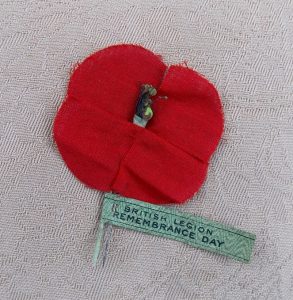
The red poppy is worn to show support for the Armed Forces community and to remember those members of that community who lost their lives on active service since the beginning of the First World War. It also honours the contribution of civilian services and the uniformed services which contribute to national peace and security and acknowledges innocent civilians who have lost their lives in conflict and acts of terrorism.
During the last ten years, poppies of other colours have been introduced: the black poppy to commemorate people of all nations of African, Black, West Indian and Pacific Islander heritage who contributed to war efforts, and the purple poppy to remember animals that lost their lives in war,
The white poppy, however, has a much longer history which is surprisingly similar to that of the red poppy because it was women also who started this movement as a response to the great losses of the First World War. The Co-operative Women’s Guild had become involved in peace activism before the war. In the years, that followed, they sought to change the social and political conditions that encouraged or gave rise to wars across the world as well as opposing the international arms trade. It was at this time when the guild numbered over 70,000 members throughout the United Kingdom, that they started to sell white poppies as an alternative to the red ones. The Peace Pledge Union took over their distribution from 1936, and a year later the first white poppy wreaths were laid alongside the red ones on Remembrance Day.
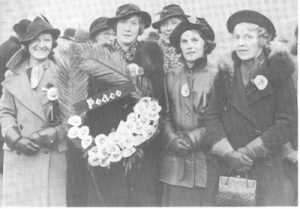
Today white poppies are worn by thousands of people across the UK and beyond. Their purpose is to remember all victims of war of all nationalities, both civilians and members of the armed forces. This includes the millions across the world who have been made homeless by war, families and communities torn apart, and those killed or imprisoned for refusing to fight and for resisting war. By drawing attention to the human cost of military conflict, the white poppy challenges any attempts to glamourise or celebrate war. It also symbolizes a commitment to peace, to finding non-violent solutions to conflicts and to tackling the underlying causes of warfare, such as poverty, inequality and competition over natural resources.

In our congregation and in our local community this week there are people who are wearing red poppies, white poppies, neither and both, reflecting a range of attitudes to Remembrance and different approaches to seeking peace. During the last few weeks, inspired by our Gospel passages from St Luke, we have been exploring what Jesus means when he speaks of the Kingdom of God and who is part of it. What we discovered is that all kinds of people are invited to be part of the Kingdom community: pharisees and tax collectors, fishermen and zealots, prostitutes and centurions. Despite our differences, we are all children of God who is Love, called to pray for each other and to work together for the coming of God’s kingdom. As followers of Christ, what unites us is much greater than that which divides us. Whatever we have on our lapel this week, we are all called to always remember those who have died or suffered because of war and to tirelessly work together for a just peace throughout the world..
Collect for Remembrance Sunday
O God, it is your will to hold both heaven and earth in a single peace. Let the design of your great love shine on the waste of our wraths and sorrows, and give peace to your Church, peace among nations, peace in our homes, and peace in our hearts; through your Son Jesus Christ our Lord, who lives and reigns with you and the Holy Spirit, one God, now and for ever. Amen.




